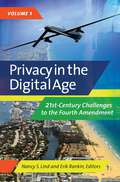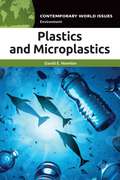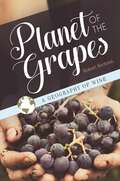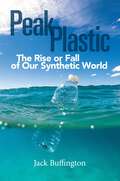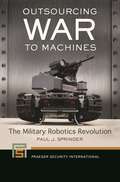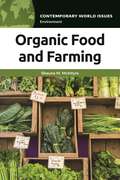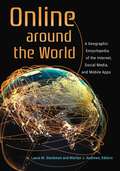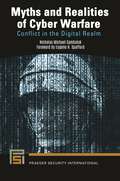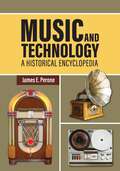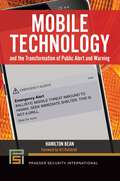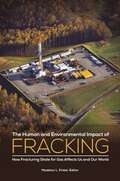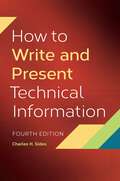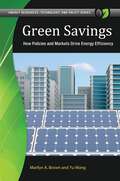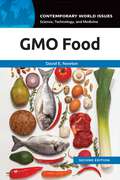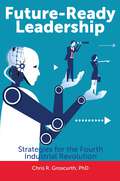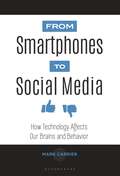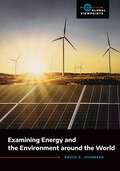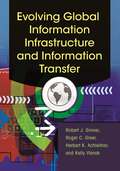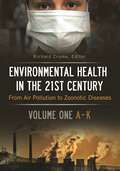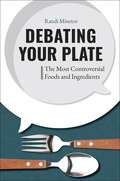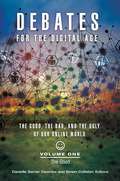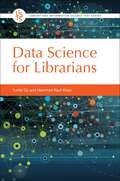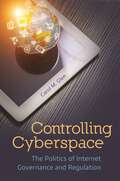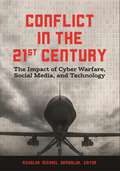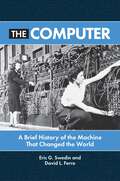- Table View
- List View
Privacy in the Digital Age [2 volumes]: 21st-Century Challenges to the Fourth Amendment [2 volumes]
by Nancy S. Lind and Erik RankinA collection of expert essays examines the privacy rights that have been lost in the post-9/11 era—giving students and others the knowledge they need to take back their constitutional protections.This timely two-volume collection shares information every citizen should have, tackling the erosion of privacy rights engendered by the ability of digital technology to intercept, mine, and store personal data, most often without the knowledge of those being monitored. Examining its subject through the lens of Fourth Amendment rights, the work focuses on technological advances that now gather personal data on an unprecedented scale, whether by monitoring social media, tracking cell phones, or using thermal imaging to watch people's movement. It also examines the possible impact of the widespread gathering of such data by law enforcement and security agencies and by private corporations such as Google.Organized by hot-button topics confronting U.S. citizens in the post-9/11 era, the work reviews the original intent of the Fourth Amendment and then traces the development and erosion of interpretations of that amendment in the 21st century. Topical essays offer a comprehensive treatment and understanding of current Fourth Amendment issues, including those that have been brought before the courts and those relative to the continuing governmental and societal emphasis on security and public safety since the Columbine shootings in 1999 and the events of September 11, 2001.
Plastics and Microplastics: A Reference Handbook (Contemporary World Issues)
by David E. NewtonPlastic plays a vital role in today's world but has become increasingly problematic. Plastics and Microplastics: A Reference Handbook discusses the history and evolution of plastic and its many uses, both in the United States and around the world.Beginning with a history of plastic—from the first scientific discovery of the material to its diversity of forms and uses in the present day—Plastics and Microplastics: A Reference Handbook discusses the history and evolution of plastic and its many uses, both in the United States and around the world. Importantly, it delves into the problems and controversies concerning plastic and microplastics, such as the pollution of oceans, rivers, and streams; its exceptionally long shelf life; its contribution to air pollution; and ingestion of microplastics by marine life.One of the most valuable aspects of the book is its survey of the history of plastics and microplastics conducted in a manner that helps readers to identify key issues to address. Moreover, it discusses both implemented and proposed solutions. A perspectives chapter includes a broad range of voices, allowing crucial, diverse perspectives to round out the author's expertise.
Planet of the Grapes: A Geography of Wine
by Robert SechristA fascinating and comprehensive introduction to the geography, culture, and history of wine that identifies the significance of this simple beverage throughout human history and today.Wine was one the key founding foods of Western culture (bread and oil being the other two). It has played a key role in human history for thousands of years, having been used for enjoyment, rituals, and religious purposes; today, the production and consumption of wine is a billion-dollar industry that plays an important role in the global economy. Planet of the Grapes: A Geography of Wine provides an interesting and accessible lens through which students can learn about geography, culture, society, history, religion, and the environment. The chapters cover the historical geography of wine, document how drinking wine has often been condemned as a vice, and describe wines by region and type, thereby providing a cultural geography of wine.Readers will learn about the historical geography of wine, terroir (the environmental conditions that affect grape crops), grape biogeography, the process of winemaking from a geographic perspective, the economic global significance of the wine trade, the ongoing love-hate relationship between wine and government, and what makes individual wine regions distinct. The content is written to be comprehensible to individuals without detailed previous knowledge about wine but provides detailed information and insight that wine connoisseurs will find engaging. Additionally, through the story of wine comes a unique telling of the social transformations in America that have resulted from sources such as anti-immigrant sentiment, pseudoscience, and censorship.
Peak Plastic: The Rise or Fall of Our Synthetic World
by Jack BuffingtonShows why plastics, in aggregate, have become a toxin to humans, wildlife, and the planet, and proposes novel solutions that involve neither traditional recycling nor giving up plastic."Plastics!" In the 50 years since Dustin Hoffman's character in The Graduate was instructed that this was the career field of the future, we have not been able to escape this ubiquitous but poorly understood material. Author Jack Buffington argues that the plastics crisis is careening toward a tipping point from which there will be no return. There is still time, however, to do something about this crisis if we have the imagination and the will to move away from the failed policies of the past. This book is the first to propose a new model for linking our synthetic world to the natural one, rather than seeking to treat them as separate entities. The key is supply chain innovation. Buffington presents five market-based solutions based on this principle that will allow consumers to continue to use plastic, which has in many ways enabled our way of life. Alongside these proposed solutions, he also addresses the proliferation of plastic as we know it—growth that, if left unchecked, will lead to a "planetary crisis," according to the United Nations—and considers how the material itself might be adapted for a sustainable future.
Outsourcing War to Machines: The Military Robotics Revolution (Praeger Security International)
by Paul J. SpringerMilitary robots are affecting both the decision to go to war and the means by which wars are conducted. This book covers the history of military robotics, analyzes their current employment, and examines the ramifications of their future utilization.Robotic systems are the future of military conflicts: their development is already revolutionizing the nature of human conflict—and eroding the standards of acceptable behavior in wartime. Written by a professor who teaches strategy and leadership for the U.S. Air Force, one of the global leaders in the development and utilization of military robots, this book both addresses the history of military robotics and discusses the troubling future ramifications of this game-changing technology.Organized both chronologically and thematically, the book's chapters describe the development and evolution of unmanned warfare; clarify the past, current, and future capabilities of military robotics; and offer a detailed and convincing argument that limits should be placed upon their development before it is too late. This standout work presents an eye-opening analysis that military personnel, civil servants, and academic instructors who teach military history, social policy, and ethics can ill afford to ignore, and will also provide the general public with information that will correct misconceptions about military robotics derived through popular culture and the news media.
Organic Food and Farming: A Reference Handbook (Contemporary World Issues)
by Shauna M. McIntyreOrganic Food and Farming: A Reference Handbook is a valuable resource for students and general readers curious about the history, evolution, and growth of the organic food movement.Organic Food and Farming: A Reference Handbook begins with a deep dive into the origins of organic farming, offering a clear discussion of what constitutes organic production and how that has changed over time. Next, the volume provides a comprehensive overview of growth of organics as both an industry and a social movement and the inherent challenges that occur from trying to be both. The book additionally covers controversial issues and challenges, along with good news about what is working and what is possible. Included are essays by scholars, farmers, and experts working with NGOs as well as profiles of key people and organizations in the organic sector. Additional chapters include data and documents, a comprehensive resource list, and a detailed chronology of the key events in the history of the organic sector. Distinguishing it from others that laud or dismiss organic food and farming practices is this book's objective nature, which allows it to be used as a definitive resource on the topic.
Online around the World: A Geographic Encyclopedia of the Internet, Social Media, and Mobile Apps
by Laura M. Steckman and Marilyn J. Andrews, EditorsCovering more than 80 countries around the world, this book provides a compelling, contemporary snapshot of how people in other countries are using the Internet, social media, and mobile apps.How do people in other countries use the social media platform Facebook differently than Americans do? What topics are discussed on the largest online forum—one in Indonesia, with more than seven million registered users? Why does Mongolia rate in the top-ten countries worldwide for peak Internet speeds? Readers of Online around the World: A Geographic Encyclopedia of the Internet, Social Media, and Mobile Apps will discover the answers to these questions and learn about people's Internet and social media preferences on six continents—outside of the online community of users within the United States. The book begins with an overview of the Internet, social media platforms, and mobile apps that chronologically examines the development of technological innovations that have made the Internet what it is today. The country-specific entries that follow the overview provide demographic information and describe specific events influenced by online communications, allowing readers to better appreciate the incredible power of online interactions across otherwise-unconnected individuals and the realities and peculiarities of how people communicate in today's fast-paced, globalized, and high-technology environment. This encyclopedia presents social media and the Internet in new light, identifying how the use of language and the specific application of human culture impacts emerging technologies and communications, dramatically affecting everything from politics to social activism, education, and censorship.
Myths and Realities of Cyber Warfare: Conflict in the Digital Realm (Praeger Security International)
by Nicholas Michael SambalukThis illuminating book examines and refines the commonplace "wisdom" about cyber conflict—its effects, character, and implications for national and individual security in the 21st century."Cyber warfare" evokes different images to different people. This book deals with the technological aspects denoted by "cyber" and also with the information operations connected to social media's role in digital struggle.The author discusses numerous mythologies about cyber warfare, including its presumptively instantaneous speed, that it makes distance and location irrelevant, and that victims of cyber attacks deserve blame for not defending adequately against attacks. The author outlines why several widespread beliefs about cyber weapons need modification and suggests more nuanced and contextualized conclusions about how cyber domain hostility impacts conflict in the modern world.After distinguishing between the nature of warfare and the character of wars, chapters will probe the widespread assumptions about cyber weapons themselves. The second half of the book explores the role of social media and the consequences of the digital realm being a battlespace in 21st-century conflicts. The book also considers how trends in computing and cyber conflict impact security affairs as well as the practicality of people's relationships with institutions and trends, ranging from democracy to the Internet of Things.
Music and Technology: A Historical Encyclopedia
by James E. PeroneThis book introduces readers to the most significant technological developments in music making and listening, including such topics as metronomes and the development of music notation as well as synthesizers, the latest music collaboration apps, and other 21st-century technologies.Rather than focusing on technical and mechanical details, Music and Technology: A Historical Encyclopedia features the sociological role of technological developments by highlighting the roles they have played in society throughout time.Students and music fans alike will gain valuable insight from this alphabetized encyclopedia of the most significant examples of technological changes that have impacted the creation, production, dissemination, recording, and/or consumption of music. The book also contains a chronology of milestone events in the history of music and technology as well as sidebars that focus on several key individual musicians and inventors.
Mobile Technology and the Transformation of Public Alert and Warning (Praeger Security International)
by Hamilton BeanThis timely book provides the inside story of the development of mobile public alert and warning technology in the United States and addresses similar systems being used in Australia, Canada, Japan, and the Netherlands.This book provides a comprehensive account of how mobile-smartphone systems are transforming the practice of public alert and warning in the United States. Recent events have vaulted mobile alert and warning technology to the forefront of public debates concerning the hazards of the digital age. False alarms of ballistic missile attacks on Hawaii and Japan, the non-use of mobile alerts during the Northern California wildfires, and the role this technology plays in supporting police manhunts and counterterrorism efforts have prompted reconsideration of how these systems are used.Drawing upon interviews with officials, executives, experts, and citizens, the book provides an in-depth analysis of the events and contexts influencing the trajectory of mobile public alert and warning and charts a course for its improvement. The book first introduces readers to the high stakes involved in the transformation of public alert and warning, explaining how new research is revealing the benefits, limitations, and risks of mobile technology in the disaster communication context. Three case studies then illustrate issues of risk, trust, and appropriateness in mobile public alert and warning.
The Human and Environmental Impact of Fracking: How Fracturing Shale for Gas Affects Us and Our World (Public Health Issues and Developments)
by Madelon L. FinkelFracking for gas trapped in shale could be a game changer in the quest to find alternatives to dirty fossil fuels, but it also has potential for harm. This book provides "one-stop shopping" for everyone who wants to know more about the issues.Oil and gas account for a large percentage of the world's energy consumption, and the search for new ways to extract both from the earth is a global quest. Fracking is viewed as an energy game-changer but is a controversial topic about which there is much misunderstanding. This unbiased work was written to bring clarity to the issues. Under the guidance of an internationally recognized public health expert, this book provides a comprehensive look at unconventional natural gas development from many different perspectives.Written for the layperson, the book dispels myths surrounding fracking, corrects misconceptions, and offers impartial, scientifically based information on both benefits and challenges. Readers will learn about the effects fracking has on the environment—our water, air, and climate—as well as on human and animal health. The contributors also look at the economics of fracking and at its socioeconomic impact on local communities and nations. They discuss legal and ethical issues related to the practice and, in keeping with the intent to provide a fair and balanced overview, share the industry perspective as well.
How to Write and Present Technical Information
by Charles H. SidesThoroughly updated to discuss the use of tools such as Skype and social media, this concise volume shows how effective communication—via written text and spoken presentations—can positively impact project management in professional environments.Professional communications are the "information product" of all organizations and businesses. Based on that premise, this book offers communications strategies that will benefit any organization that disseminates technical information in-house and/or to customers. The popular work provides easy-to-understand and apply guidelines for designing and writing effective technical documents, as well as other related communications. What makes this new edition especially valuable is that it maintains the quality of information that distinguished the previous editions, but is now updated to encompass current technology and trends, including today's prevalent communication tools such as social media.The book begins by looking at skills common to all technical writing and offering general advice on designing and writing reports. Next is a discussion of specific types of reports along with common problems and issues writers face. Finally, the work overviews other forms of communications such as professional presentations. The updated material also considers the growing importance of interviews and focus groups as information-gathering tools, the influence of visual rhetoric, and the use of technologies such as Skype and webinars.
Green Savings: How Policies and Markets Drive Energy Efficiency (Energy Resources, Technology, and Policy)
by Marilyn A. Brown Yu WangThis landmark work lauds the benefits of decreased energy consumption, investigating its relationship to public policy and analyzing its potential billion-dollar benefits to the U.S. economy.U.S. consumers tend to use energy indiscriminately—something they may no longer be able to do with impunity. This game-changing book asserts that reducing energy consumption should be a frontline strategy to address global climate change, threats to energy security, and the challenge of grid reliability. The book supports two bold arguments: that policies motivating greater investment in high energy efficiency should be a priority, and that energy efficiency can help the nation in times of crisis. To make their case for the necessity of prioritizing demand reduction, the authors examine the policies and markets operating in a number of leading cities, states, and nations across the globe to uncover the keys to their success. These examples show how demand-side strategies can significantly reduce pollution, cut costs, and make the electric grid more resilient. The authors explain why these technologies are not widely adopted and assess the potential savings they can produce. The book will be an eye-opener for policymakers, energy professionals, and the public as it demonstrates how cost-effective demand reduction policies can improve air quality, strengthen electricity markets, and generate jobs.
GMO Food: A Reference Handbook (Contemporary World Issues)
by David E. NewtonGMO Food: A Reference Handbook offers an in-depth discussion of genetically modified food. It covers the history of, opposition to, regulation of, and labeling of genetic modifications, along with the potential benefits and harm involved.GMO Food: A Reference Handbook is intended to serve as a research guide for young adults in high school and beyond. Students at all grade levels should be able to use the book as an introduction to the history of genetic engineering of organisms and the use of this technology for the development of new forms of crops and foods.They will learn briefly about historic methods of plant and animal modification (such as cross-breeding) and, in more detail, how discoveries since the late nineteenth century have greatly changed the process of plant and animal modification. These discoveries include important steps forward in genetics, biochemistry, molecular biology, genetic engineering, and related fields. They will also learn about the variety of social, political, philosophical, economic, and other issues that have arisen alongside these scientific advances, as well as about some of the laws, regulations, and other solutions that have been developed for dealing with the range of attitudes about genetically modified foods. The second edition covers developments since 2014.
Future-Ready Leadership: Strategies for the Fourth Industrial Revolution
by Chris R. GroscurthProvides executive leadership teams with information, tools, and advice they need to lead their organizations into the "future of work," characterized by transformative, smart, and connected technologies already under way, including artificial intelligence, the Internet of things, and automation.The technological and economic forces of the fourth industrial revolution (4IR) are shifting organizations in radical new directions. Automation is taking place not only in factories but in retail environments, and it is not just powerful or precise: it is intelligent, and it learns. Leaders must learn to rely on new sources of data, analytics, and intelligence in their efforts to anticipate emerging trends, forecast unforeseen consequences, make sense of systems and complexity, communicate constantly, build strong networks based on trust, and ultimately, win a following.Future-Ready Leadership is an invaluable resource for leaders and leadership educators seeking to transform 4IR trends into a source of collaborative (as opposed to competitive) advantage. A blueprint for reshaping the future of work, the book meets readers' "awareness need" by exploring cutting-edge research on technology's impact on the workplace. Each chapter uses data to set up a specific future of work leadership challenge, offering readers practical solutions and advice, actionable recommendations, and tools for reflection and action that can be put into practice right away.
From Smartphones to Social Media: How Technology Affects Our Brains and Behavior
by Mark CarrierThis book examines how today's technology, as it includes smartphones, computers, and the internet, shapes our physical health, cognitive and psychological development, and interactions with one another and the world around us.Technology has become a ubiquitous part of modern life, but its impact on our physical, psychological, and social health and development runs just as deep as does our dependence upon it. How is the development of babies' brains affected by their playing with their parents' smartphones and tablets? How have computers altered the way we process and learn information? How have texting and social networking sites such as Facebook changed the way in which we interact with others? Can online dating lead to meaningful real-world relationships? From Smartphones to Social Media investigates these questions and many complex issues related to technology. Readers will discover what researchers know about how the use of technology affects us through accessibly written, thematic chapters. The main text is complemented by a collection of case studies and interviews with a variety of experts, providing insight into how technology's positive and negative effects manifest in our everyday lives and what we can do to mediate the negative ones.
Examining Energy and the Environment around the World (Global Viewpoints)
by Bruce E. JohansenThis volume addresses ten issues pertaining to energy and the environment, such as climate change, fossil fuels, endangered species, and renewable energy, and examines how these issues are affecting countries around the world.In the industrial age, first powered by coal and then more often by oil, environmental degradation nearly inevitably followed resource exploitation and energy production. This book examines environmental issues in specific countries around the world as well as solutions some of these countries have discovered in order to help save the environment.This volume includes 10 chapters, each addressing a specific issue relating to energy and the environment as it pertains to a variety of countries, including toxic chemicals, pollution, deforestation, and climate change. Each chapter begins with an introduction to the issue. Following the chapter introduction, each chapter highlights that issue in eight countries and provides historic perspective. This work provides an overview for high school students and college students at the undergraduate level on 10 important topics that address matters relating to energy and the environment in the 21st century.
Evolving Global Information Infrastructure and Information Transfer
by Robert J. Emeritus Roger C. Greer Herbert K. Achleitner Kelly VisnakThis book explains the rapidly changing, complex flow of information in the context of 21st-century culture, policy, technology, and economics—an essential resource for librarians and information specialists in all types of settings.The role of information professionals today is to interact creatively with clientele: to help them navigate the information infrastructure. Shattering the concept of the library as a place, Evolving Global Information Infrastructure and Information Transfer describes "the library" as transformed to a dynamic virtual presence in the information infrastructure, where people are the most important resources in a digital library or information center—not the collections. Instead of focusing on specific technologies, which are always changing, this book examines the "big picture" of how information is created, recorded, mass produced, distributed, and utilized in society. This unique approach enables readers to better understand how they fit into this changing world, to envision their place in the digital age, and to assume a leadership role that ensures the success of their clients as well as themselves. This standout work is ideally suited for all types of librarians, educators, information workers, members of the research community, and policymakers in public and private sector organizations.
Environmental Health in the 21st Century [2 volumes]: From Air Pollution to Zoonotic Diseases [2 volumes]
by Richard CrumeThis concisely written and easy-to-read resource provides information on emerging issues and valuable historical context that enables students to better understand a broad range of environmental health topics, from pollution to infectious diseases, natural disasters, and waste management.As technology enables better insight into the world we live in, we are increasingly aware of environmental health concerns and risks, from contaminated air and water to infectious diseases and light and noise pollution. Because the quality of our lives depends on the quality of our environment, everyone should be informed about issues in environmental health. Environmental Health in the 21st Century: From Air Pollution to Zoonotic Diseases presents hundreds of encyclopedic entries written by expert researchers and practitioners, a history of environmental health, and interviews with subject experts that broadly survey the field of environmental health. The set covers myriad subjects in environmental health, including all types of environmental pollution; the spread of communicable diseases and other issues in the health sciences; waste management practices; the effects of climate change on human health; children's environmental health concerns; environmental health problems unique to the urban environment; and emerging threats such as the Zika virus and hospital-acquired infections. Readers will learn about steps they can take to reduce their environmental risk, understand the effects of key international treaties and conventions and the contributions of key figures in environmental health, and also reflect on potential solutions for global challenges in environmental pollution, health sciences, energy and climate, waste management, and the built environment. No other book on the market today addresses the environmental health field in such a comprehensive manner, with the latest information provided by expert practitioners, all packed into two concise volumes.
Debating Your Plate: The Most Controversial Foods and Ingredients
by Randi MinetorThis book examines the most controversial foods and ingredients, providing an objective, well-balanced look at the health benefits and risks of each. It equips readers with the information they need to make their own informed decisions about what they eat.Most people aspire to eat healthy, but what exactly does that mean? While some foods are universally acknowledged as beneficial, such as many vegetables, and others are widely condemned, such as added sugar, many foods have a more controversial reputation.Debating Your Plate: The Most Controversial Foods and Ingredients offers in-depth coverage of some of the most hotly debated items on grocery store shelves and dinner plates. Each entry provides thorough background and contextual information before examining the unique issues and controversies that surround that food or ingredient. By presenting both sides of the argument in clear, unbiased language, the book allows readers to form their own opinions about which items to include in their diet and which to avoid. On a larger scale, the book also examines why nutrition science is so prone to controversy and ambiguity, and it offers readers guidance on how to evaluate health claims for themselves.
Debates for the Digital Age [2 volumes]: The Good, the Bad, and the Ugly of Our Online World [2 volumes]
by Danielle Sarver Coombs and Simon CollisterBy evaluating the Internet's impact on key cultural issues of the day, this book provides a comprehensive overview of the seismic technological and cultural shifts the Internet has created in contemporary society.Books about Internet culture usually focus on the people, places, sites, and memes that constitute the "cutting-edge" at the time the book is written. That approach, alas, renders such volumes quickly obsolete. This provocative work, on the other hand, focuses on overarching themes that will remain relevant for the long term. The insights it shares will highlight the tremendous impact of the Internet on modern civilization—and individual lives—well after specific players and sites have fallen out of favor.Content is presented in two volumes. The first emphasizes the positive impact of Internet culture—for example, 24-hour access to information, music, books, merchandise, employment opportunities, and even romance. The second discusses the Internet's darker consequences, such as a demand for instant news that often pushes journalists to prioritize being first over being right, online scams, and invasions of privacy that can affect anyone who banks, shops, pays bills, or posts online. Readers of the set will clearly understand how the Internet has revolutionized communications and redefined human interaction, coming away with a unique appreciation of the realities of today's digital world—for better and for worse.
Data Science for Librarians (Library and Information Science Text Series)
by Yunfei Du Hammad Rauf KhanThis unique textbook intersects traditional library science with data science principles that readers will find useful in implementing or improving data services within their libraries.Data Science for Librarians introduces data science to students and practitioners in library services. Writing for academic, public, and school library managers; library science students; and library and information science educators, authors Yunfei Du and Hammad Rauf Khan provide a thorough overview of conceptual and practical tools for data librarian practice. Partially due to how quickly data science evolves, libraries have yet to recognize core competencies and skills required to perform the job duties of a data librarian. As society transitions from the information age into the era of big data, librarians and information professionals require new knowledge and skills to stay current and take on new job roles, such as data librarianship. Such skills as data curation, research data management, statistical analysis, business analytics, visualization, smart city data, and learning analytics are relevant in library services today and will become increasingly so in the near future. This text serves as a tool for library and information science students and educators working on data science curriculum design.
Controlling Cyberspace: The Politics of Internet Governance and Regulation
by Carol M. GlenInformed by theories of international relations, this book assesses global political conflicts over cyberspace. It also analyzes the unique governance challenges that the Internet presents, both in terms of technical problems and control over content.The Internet is a resource of unparalleled importance to all countries and societies, but the current decentralized system of Internet governance is being challenged by some governments that seek to assert sovereign control over the technology. The political battles over governing the Internet—ones that are coming and conflicts that have already started—have far-reaching implications. This book analyzes the shifting nature of Internet governance as it affects timely and significant issues including Internet freedom, privacy, and security, as well as individual and corporate rights.Controlling Cyberspace: The Politics of Internet Governance and Regulation covers a broad range of issues related to Internet governance, presenting a technical description of how the Internet works, an overview of the Internet governance ecosystem from its earliest days to the present, an examination of the roles of the United Nations and other international and regional organizations in Internet governance, and a discussion of Internet governance in relation to specific national and international policies and debates. Readers will consider if access to the Internet is a human right and if the right to freedom of expression applies equally to the exchange of information online. The book also addresses how the digital divide between those in developed countries and the approximately 5 billion people who do not have access to the Internet access affects the issue of Internet governance, and it identifies the challenges involved in protecting online privacy in light of government and corporate control of information.
Conflict in the 21st Century: The Impact of Cyber Warfare, Social Media, and Technology
by Nicholas Michael SambalukThis reference work examines how sophisticated cyber-attacks and innovative use of social media have changed conflict in the digital realm, while new military technologies such as drones and robotic weaponry continue to have an impact on modern warfare.Cyber warfare, social media, and the latest military weapons are transforming the character of modern conflicts. This book explains how, through overview essays written by an award-winning author of military history and technology topics; in addition to more than 200 entries dealing with specific examples of digital and physical technologies, categorized by their relationship to cyber warfare, social media, and physical technology areas. Individually, these technologies are having a profound impact on modern conflicts; cumulatively, they are dynamically transforming the character of conflicts in the modern world.The book begins with a comprehensive overview essay on cyber warfare and a large section of A–Z reference entries related to this topic. The same detailed coverage is given to both social media and technology as they relate to conflict in the 21st century. Each of the three sections also includes an expansive bibliography that serves as a gateway for further research on these topics. The book ends with a detailed chronology that helps readers place all the key events in these areas.
The Computer: A Brief History of the Machine That Changed the World
by Eric G. Swedin David L. FerroThis book, aimed at general readers, covers the entirety of computing history from antiquity to the present, placing the story of computing into the broader context of politics, economics, society, and more.Computers dominate the world we live in, and this book describes how we got here. The Computer: A Brief History of the Machine That Changed the World covers topics from early efforts at mathematical computation back in ancient times, such as the abacus and the Antikythera device, through Babbage's Difference Engine and the Hollerith Tabulating Machines of the 19th century, to the eventual invention of the modern computer during World War II and its aftermath. The scope of the text reaches into the modern day, with chapters on social media and the influence of computers and technology on recent elections.The information in this book, perfect for readers new to the topic or those looking to delve into the history of computers in greater detail, can be accessed both chronologically and topically. With chapters focusing on larger time periods as well as shorter subsections covering specific people and topics, this book is designed to make the history of computing as approachable as possible.
